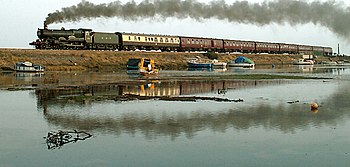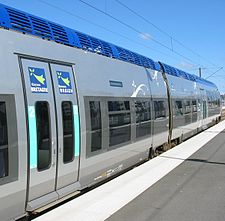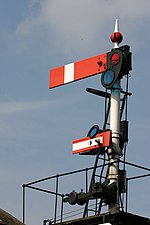Railway
The railway (from the Latin: ferre, "iron", and rail) or rail transport is a system for transporting people and goods guided on a railway.
Although it is normally understood that the rails or rails are made of steel or iron, which make the road or railway on which the trains circulate, within this classification are included means of transport that use other types of guidance, such as magnetic levitation trains.
It is a transport with comparative advantages in certain aspects, such as the consumption of fuel per ton/kilometer transported, the entity of the environmental impact that it causes or the possibility of carrying out mass transport, which make its use relevant in the world modern.
History
Lines on rails
The first notice of a rail transportation system was a three kilometer line following the Diolkos Road, which was used to transport boats on platforms across the Isthmus of Corinth during the VI a. C. The platforms were pushed by slaves and guided by slits excavated on the stone. The line kept running for 600 years.
Rail transport began to reappear in Europe after the Early Middle Ages. The first information about a transport of this type on the European continent in this period appears in a stained glass window in the cathedral of Freiburg im Breisgau around 1350. In 1515, Cardinal Matthäus Lang described a funicular railway in the castle of Hohensalzburg (Austria).) called «Reisszug». The line used wooden rails and was powered by a hemp rope moved by human or animal power. The line continues to operate today, although completely replaced by modern equipment, being one of the oldest lines still in service.
From 1550, narrow-gauge lines with wooden rails became widespread in European mines. During the 17th century Wooden wagons moved ore from inside the mines to canals where the cargo was transferred to river transport or carts. The evolution of these systems led to the appearance of the first permanent streetcar in 1810, the "Leiper Railroad" in Pennsylvania.
The first railway itself (that is, with iron rails) had rails made up of a wooden body covered by sheet metal, and was manufactured in 1768. This allowed the development of more complex track devices. At first, there were only end-of-line loops to reverse the compositions, but switch changes soon appeared. From 1790 the first all-steel rails were used in the United Kingdom. In 1803, William Jessop inaugurated the line " Surrey Iron Railway" south of London, being the first public blood-traction (horse-drawn) railway. The invention of wrought iron in 1820 made it possible to overcome the problems of the first iron rails, which were fragile and short, increasing its length to 15 meters. In 1857 steel rails began to be made definitively.
The Age of Steam
The development of the steam engine prompted the idea of creating steam locomotives that could pull trains along lines. The first was patented by James Watt in 1769 and revised in 1782, but the engines were too heavy and underpowered to be used in locomotives. In 1804, using a high precision motor, Richard Trevithick presented the first locomotive capable of pulling a train in Merthyr Tydfil (United Kingdom). Carried out together with Andrew Vivian, the test was relatively successful, since the locomotive broke the brittle iron sheet rails.
In 1811, John Blenkinsop designed the first working locomotive to run on the line between Middleton and Leeds. The locomotive, named Salamanca, was built in 1812. In 1825, George Stephenson built the Locomotion for the line between Stockton and Darlington, in north-east England, which was the first steam locomotive that pulled public transport trains. In 1829 he also built the locomotive The Rocket. The success of these locomotives led Stephenson to create the first company to build steam locomotives which were used on the lines in Europe and the United States.
In 1830 the first intercity railway line was opened, the line between Liverpool and Manchester. The track used was of the same type as previous ones, such as the railway between Stockton and Darlington. Its gauge was 1,435 mm, currently known as international gauge since it is used by approximately 60% of current railways. The same year the first section of the line between Baltimore and Ohio was inaugurated, the first to unite individual lines in a network.
In the years that followed, the success of steam locomotives saw railway lines and locomotives spread throughout the world.
Electrification and dieselization
Electric trains were first tested by Robert Davidson in 1838, when he built a battery-powered carriage capable of 4 mph. The first railway with electrical supply on the track was the tram that ran in 1883 between Portrush and Giant's Causeway, in the north of Ireland, which used power from a third rail. Overhead railway power cables were introduced in 1879, by Siemens in Berlin, on trams that until then had been pulled by mules or horses.
The first electrified conventional railway line was the Roslag line in Sweden. In the 1890s some large cities, such as London, Paris and Mexico, used this new technique to build urban subway lines. In medium-sized cities, trams became commonplace and were the only means of public transportation for several decades. All of these lines used direct current, and the first line to use alternating current was opened in Austria in 1904.
Steam locomotives require fairly high maintenance to function. After the Second World War, personnel costs increased significantly, which made steam traction more expensive than the rest. At the same time, the war prompted the development of internal combustion engines, which made diesel locomotives cheaper and more powerful. This caused several railway companies to initiate programs to convert all their locomotives for non-electrified lines to diesel locomotives.
As a result of the large-scale construction of highways after the war, rail transport became less popular, and air transport began to occupy the market for very long-haul travel. Many trams were replaced by buses, while the need for transfers made the transfer of goods over medium distances unprofitable. In addition, events such as the Great Streetcar Scandal in the United States caused rail transport to be considerably reduced.
The oil crisis of 1973 changed the downward trend of streetcars. He made those that had not been dismantled continue to this day, once again being more profitable. The introduction of containers also contributed to improving the profitability of freight transport by rail.
Faster Trains
The first high-speed commercial train was inaugurated in 1939 in Italy with the ElettroTreno ETR 200, reaching the then world record of 204 km/h near Milan.
Currently, the railway that exceeds 250 km/h on average is considered High Speed. In this sense, in 1964, the first high-speed rail line, called Shinkansen, bullet train, was inaugurated in Japan to solve the transportation problem between the country's populated cities. Over time, this system spread to other countries, such as France, Spain and Germany, which brought back the intercity traveler.
Innovation
Throughout the 1970s, greater automation was introduced, especially in intercity transportation, reducing operating costs. Some streetcar lines were converted to light rail lines, other lines were built in cities that had phased out streetcars decades earlier. In the 1990s, the focus of attention was placed on improving accessibility, making the train the solution for transporting the disabled.
Innovation in new rail systems continues today, especially in fields such as high speed.
Rolling stock
Rolling stock is made up of all the equipment that circulates (rolls) along the railroad tracks. They are divided into two groups: the traction material, the locomotives, and the drag material or equipment, which is all that the locomotive drags or pushes coupled to it, on the tracks. The set of rolling equipment attached to each other that pulls or pushes the locomotive, or is on the track waiting to be, is called composition or formation. The set of the locomotive with the composition is known as a train. Depending on the type of service they provide, the trains are called: cargo, passenger, service, works or mixed.
In turn, a division can be made by these types of vehicles between: locomotives, passenger cars, wagons, railcars and train units.
Train
Series of wagons coupled to a locomotive. Also the wagons can carry goods or passengers, which means that there are two types of train. A more recent variant is the self-propelled train, in which the wagons, all, or some, have motors in their wheels, without carrying a proper locomotive.
Types and variants
- Atmospheric: The one that uses the compressed air as a motor inside a tube that, pushing a piston, makes it drag the train
- Railroad itself said: the railway lines or networks, more usual in their variants:
- Magnetic leviation
- High speed
- Regional and local
- Funicular: it is a wired train, usually from point to point, in places of large slopes
- Metro: metropolitan train, is a predominantly urban railway. It can be completely underground, elevated or surface, but it is necessary that you have a reserved platform
- Pneumatic: Variation of the atmospheric railway in which the entire vehicle is pushed by the action of the compressed air going as a piston inside a tube.
- Tramway: it is an urban or mostly urban surface railroad
- Light train: is a type of train used specifically for transporting travelers in urban areas
- Zip trains: it is the train in which the adhesion is improved by a zip system, in places of strong slopes. In Spain, it is the one that travels from Monistrol to Montserrat.
Infrastructure
The railway infrastructure includes all the facilities and buildings necessary for the operation of the railway: stations, tracks, bridges and tunnels, signal and communication system, train blocking and guiding infrastructure, needles, etc.
Railway
- Double track: The one that in all its length has the double track, dedicating each to the march of the trains in one sense.
There are also sections of quad tracks. In these, the central routes are for the transport of merchandise and the lateral or external ones, for the transport of passengers since the external platforms allow better access. A variant is that in which the central tracks are reserved for long-distance railways (faster, with fewer stops) and the lateral ones for commuter trips.
- Simple way: The one that only has a single way in all its length and through which the trains circulate in both senses, making the crossroads of the same in the stations and some other certain points, where they are placed with such object double or separate routes.
Track gauge
The distance between the flat internal head (or mushroom) of both rails on which the trains run is called track width or gauge.
Signage
Railway traffic is regulated by signals. These can be fixed or mobile, manual, mechanical or electrical.
Railway station
A railway station, or railway station, is the point of access for passengers and freight to the railway.
Railway operation
Railway operation is the name given to the set of techniques, means and modes that guarantee the safe and fluid circulation of trains, and that routes each train to its destination according to the established schedule.
Electrification
Electrification is the name given to the traction power system that uses electrical energy to power the railway traction units.
Rail transport services
Logistics and economy
Railroad is part of a wide range of land transportation around the world, which, as a whole, allows and carries out the transportation of people and goods from the place where they are to the place where they want to go or where they are needed. At present, a combination of means (roads, railways, etc.) is used, acting in coordination for this purpose.
Social and cultural sphere
Anniversaries and railway festivals
- On 7 November, the “Día del Ferrocarrilero” is celebrated in Mexico, commemorating the heroic feat of Jesus García Corona, the Hero of Nacozari.
- The day of the ferroviary is celebrated on 1 March in Argentina, in commemoration of the transfer of exploitation of the English to the Argentine State.
- On August 30, the Argentine Railway Day is celebrated, commemorating the opening of the first railway line in Argentina on August 30, 1857.
- The first weekend of August of each year is held in Mexico the annual convention of Friends of the Railway. The headquarters city changes every year.
- San Rutenio: patron of the Association of Interventors in European Routes (AIRE), which hold two annual congresses since 1980 in Europe, one almost always in Spain and another outside Spain. The last congresses held were the 49th in Amsterdam (NL) from 20 to 23 May 2005, 50th in Almería (SP) from 20 to 24 November 2005, the 51.th in Perpignan (FR) from 25 to 28 May 2006, the 52.th in Madrid (SP) from 5 to 8 October 2006, the 53.th in Gotha (GE) from 31 May to 4 June 2007 and 54th.
Direction of circulation
Direction of traffic on double tracks in various countries.
On the left
On the right
Both ways
Move partly on the right and partly on the left in:
Contenido relacionado
Electric hybrid vehicle
Mototricycle M.T.
National Network of Spanish Railways

















